Build Your Own Blackjack Table: A Step-by-Step Guide


Intro
Building your own blackjack table can be a rewarding endeavor, especially if you're passionate about gaming and want to create a custom experience for family and friends. It's not just about slapping some felt on a piece of wood; it's a meticulous process that involves both functional considerations and a touch of personal style. Having a personal blackjack table at home can elevate game nights and even serve as a stylish piece of furniture when not in use. This guide aims to streamline your efforts, providing a thorough roadmap to ensure your built-from-scratch table meets both your aesthetic and gaming needs.
Embarking on this project requires planning and an understanding of essential materials and designs. It isn’t just a weekend hobby; it’s a blend of craftsmanship and gaming passion. Moreover, whether you're a newbie just starting or a seasoned DIY enthusiast, there are tips and tricks that can help you navigate this task with greater ease. Let's break down the journey together, starting with practical strategies that cater to various skill levels.
Prelims to Blackjack Tables
When it comes to hosting a casino night at home or setting up a private gaming space, few things can rival the allure of a custom blackjack table. The creation of this piece isn’t just a matter of function; it’s about providing the right environment for exhilarating gameplay, making an unforgettable experience for everyone involved. With numerous flashy games gaining traction, blackjack remains a classic choice. It's beloved not just for its gameplay, but also for the sociable aspect it brings to the gathering. A tailored table adds a sense of gravitas to the experience, letting players dive into a world where every hand is potentially life-changing.
The Significance of a Customized Table
Opting for a custom blackjack table carries a lot of weight. Why settle for a plain, store-bought option when you can build something that resonates with your personal style and needs? Customization offers advantages beyond mere aesthetics.
- Personal Touch: You can incorporate colors and designs that reflect your personality or the theme of your game night, making it more distinct and inviting.
- Enhanced Functionality: The dimensions of a table can be adjusted to fit snugly in its intended space, optimizing gameplay and comfort. This means no more awkward stretching or cramped quarters.
- Durability and Quality: Building your own table allows you to select high-quality materials. Whether one opts for refined hardwood or a synthetic surface, each choice impacts the longevity and feel of the game.
Building a blackjack table becomes a personal project, allowing one to invest time and creativity into something that can be enjoyed for years to come.
Overview of Blackjack and its Popularity
Blackjack, often known as 21, stands out with its combination of strategy and luck. The aim is to beat the dealer by having a hand value closer to 21 without going over. Its simplistic rules and the blend of skillful decision-making make it appealing to newbies and seasoned gamblers alike.
- Historical Roots: Tracing its roots back to the early 17th century, it has evolved while maintaining a consistent core of excitement.
- Wide Appeal: Today, you’ll find blackjack in casinos worldwide, online platforms, and, of course, backyards for friendly gatherings. It draws in a crowd because it requires both strategic thinking and luck. Players must weigh their odds and decide whether to hit or stand, which adds an interactive layer to each game.
- Social Element: There’s a camaraderie that springs forth when sitting around a table, sharing stories, and cheering each other on. That social aspect is crucial to blackjack's lasting popularity.
Given its deep-seated history and the thrill it brings, players have continued to embrace blackjack in various formats.
As you continue reading this guide, keep in mind the significance of going beyond just materials, design, or rules. This is about crafting a gaming experience filled with energy, interaction, and personal flair.
Required Tools and Materials
Crafting a personalized blackjack table is not just about the design and aesthetic; it also hinges on having the right tools and materials. The significance of this section lies in laying a foundation for a successful project. From the moment you decide to embark on this endeavor, understanding what you’ll need is paramount.
Tools Needed for Construction
When it comes to constructing your own blackjack table, various tools will make the process smoother, more efficient, and ultimately, more enjoyable. Here's a list of essential tools you should have in your arsenal:
- Measuring Tape: Precision is key. A sturdy measuring tape ensures that every element of your table fits perfectly and functions as intended.
- Circular Saw: For cutting the wood to the necessary dimensions. You may also consider a miter saw for angled cuts.
- Drill: This will help in securing components together. Invest in both drill bits and screws to properly fasten the materials.
- Screwdriver Set: A good set of screwdrivers will be needed for assembly.
- Clamps: These come in handy while assembling parts to prevent movement during the procedure.
- Sandpaper or Orbital Sander: To ensure all surfaces are smooth and free of splinters, which is crucial for gameplay comfort.
- Level: A level will help ensure that your table is even, which is vital for fair gameplay.
Having the right tools at your disposal can save you time and reduce frustration during the build process. Each tool plays a vital role in shaping the final look of your blackjack table.
Selecting Appropriate Materials
Choosing the right materials is as important as having the right tools. The materials you select can influence the durability, comfort, and overall aesthetics of your table. Here are some materials that are commonly used:
- Plywood: Often used for the table's structure. It's strong and can be cut into different shapes to fit your design.
- MDF (Medium Density Fiberboard): Great for a smooth, flat surface; it minimizes imperfections, making it an excellent choice for the gaming top.
- Felt or Cloth: This will cover the tabletop. Different colors and textures can change the game's feel. Choose something durable and easy to clean.
- Wood for the Frame: Solid wood options, like oak or maple, add to the durability while giving your table a classic look.
- Finish: A polyurethane or varnish can protect the wood while enhancing its natural beauty. Pick a finish that suits your aesthetic preferences.
While selecting materials, consider both functionality and visual appeal. Each choice you make should align with your vision for your blackjack table.
Essential Protective Gear
Crafting your own blackjack table involves working with tools and materials that can pose safety risks. It's wise to prioritize your safety as you embark on this DIY project. Here’s a list of essential protective gear you should not overlook:
- Safety Goggles: These will protect your eyes from debris or dust that can occur while using saws and drills.
- Dust Mask: Woodworking generates fine dust; wearing a mask helps protect your lungs.
- Ear Protection: If you're using loud power tools, earplugs or earmuffs will help shield your hearing.
- Work Gloves: A good pair of work gloves provides grip and comfort while protecting your hands from cuts and scrapes.
- Apron: Wearing a sturdy apron can keep your clothes clean and provide additional protection, particularly if you’re also storing small tools.
Safety should never be an afterthought. Wearing proper protective gear not only safeguards you but also enables a focus on your artistic vision during the construction process.
For further reading on tools and safety, consider visiting these resources: Wikipedia, Britannica, and community advice on Reddit.
Design Considerations
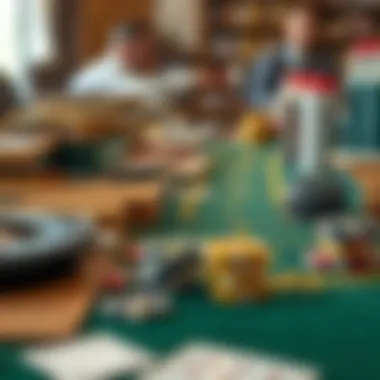
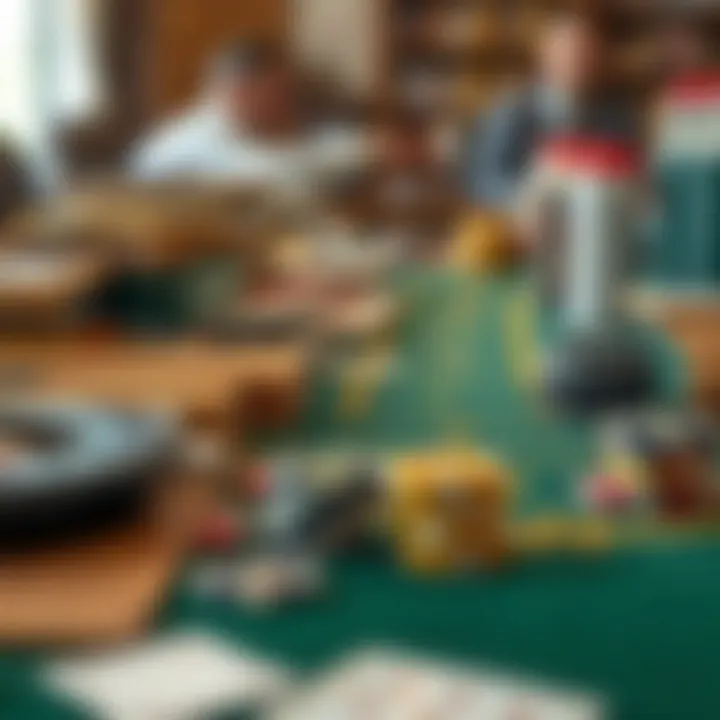
When venturing into the realm of crafting a blackjack table, the design considerations become paramount. This isn't just about function, but also about creating a space that reflects the thrill and excitement associated with the game. Proper design elements lay the groundwork for playing enjoyment and can enhance the overall ambiance of your game nights. Therefore, carefully selecting your table dimensions, tabletop design, and aesthetic elements is essential to bring your vision to life.
Table Dimensions and Configuration
The dimensions of your blackjack table are not just a matter of fitting it in your space; they influence the gameplay experience. Typically, a standard blackjack table requires enough surface area to accommodate the dealer and several players comfortably. Most professional tables come in dimensions of around 72 to 96 inches in length, providing sufficient space for players to spread out their chips and cards. However, if you're building for a more personal setup, you can customize the size based on your needs.
Additionally, consider how many players you wish to accommodate. A standard table can usually host anywhere from 6 to 7 players. You might want to tailor it for fewer players to create a more intimate atmosphere, or possibly even go for a longer layout that gives everyone plenty of room.
Choosing a Tabletop Design
The tabletop design is where creativity flourishes. You can endorse traditional aesthetics that mimic casino styles, such as a classic green felt adorned with markings for bets and zones, or opt for something tongue-in-cheek like bright blues or yellows that pop. Your choice here can reflect your personal taste or that of your guests; after all, an eye-catching tabletop can set the mood for friendly competition.
Unique Feature: Consider using materials like vinyl or specialized gaming cloths that allow for easy cleaning and durability. Those materials may be more favorable than basic felt if you anticipate entertaining frequently.
Considering Aesthetic Elements
The aesthetics can talk volumes about the experience. Elements like color schemes, finishes, and lighting all contribute significantly to the environment you wish to nurture.
Color Schemes
When considering color schemes, think about the emotions they evoke. For a classic feel, you might lean towards rich greens and deep reds, synonymous with the casino atmosphere. Interestingly, they are believed to promote focus and calm, conducting the player’s thoughts towards the game itself. It's a beneficial choice as these colors can make players feel more at ease at the table, enhancing their overall experience.
However, if you want to stand out, bright colors can also be a draw. Just keep in mind that while they offer a fun and casual vibe, they might detract from the serious feeling some players might seek.
Finishes
The finish you choose can vastly alter the character of your table. High-gloss finishes add a touch of elegance and can truly elevate the appearance of your table. More matte finishes, on the other hand, can offer a rustic appeal, lending a comforting, homey vibe to the setting.
Key Characteristic: High-gloss surfaces may have the advantage of being more visually striking, though they may require more maintenance to keep from showing scratches and fingerprints.
Lighting
Lighting plays a critical role, too. A well-lit area can enhance the playability of the game, allowing players to see their cards and chips clearly. Dimming fixtures or soft lighting can create a more relaxed atmosphere, ideal for casual play with friends.
Incorporating features like overhead pendant lights specifically designed to illuminate the table can provide the necessary illumination while offering a stylish element that does not overpower the setting.
A well-thought-out design sets not just the look, but the mood of your blackjack table, ensuring every game played is one to remember.
By giving thoughtful consideration to these design facets, you’ll not only have a table that functions well but one that adds character and charm to your gaming space. Balancing aesthetics with functionality will ultimately lead to a blackjack table that embodies not just the game, but the spirit of camaraderie it fosters.
Step-by-Step Construction Process
Building a blackjack table is no small feat, but it's a rewarding endeavor for gambling enthusiasts. This section outlines the process methodically, ensuring that each component is crafted with care. It can be a labor of love to assemble a table that not only serves its purpose but also enhances the home casino experience.
Laying the Foundation
The foundation is the backbone of your blackjack table. It’s imperative to select the right surface to ensure stability. You might choose plywood for its accessibility and sturdiness, or you might opt for high-quality MDF for a smoother finish. The key is to ensure that no matter what material you select, it’s thick enough to support the entire structure.
Measuring and cutting the foundation accurately is crucial. A miscalculation can lead to an uneven surface, causing havoc during gameplay. Take the time to double-check your measurements. Once you’ve cut it to size, ensure you sand down any edges. This can prevent splinters and gives a polished finish, contributing to the aesthetic appeal of your table.
Building the Frame
After the foundation is set, the next step is creating a robust frame. This not only provides structural integrity but also adds weight, helping to keep the table stable during intense gaming sessions. Consider using 2x4 lumber for a sturdy frame. It’s readily available, affordable, and serves the purpose effectively.
Start by cutting the lumber to the desired lengths and then assemble them into a rectangular shape, ensuring that it fits snugly around the foundation. Use wood screws to secure each joint tightly. You may also want to reinforce the corners with brackets to add extra strength. Remember, attention to detail during this step will pay off when the table is in use.
Attaching the Tabletop
Once the frame is complete, it’s time to attach the tabletop. Begin by laying your chosen tabletop material on the frame, ensuring that it extends evenly on all sides. Use wood glue to adhere the top before securing it with screws. Make sure it remains flat and even as you work; any misalignment could drastically affect gameplay and comfort.
It might be beneficial to drill pilot holes for the screws to prevent splitting the wood. As you go, keep checking that the tabletop sits level. A level surface will enhance your overall gaming experience, making it a pleasure for players and dealers alike.
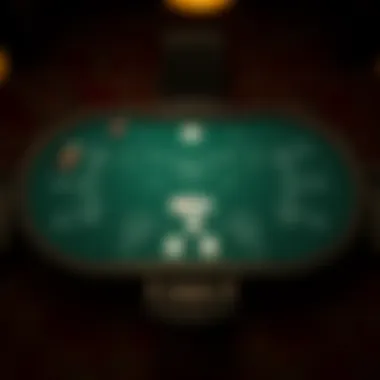
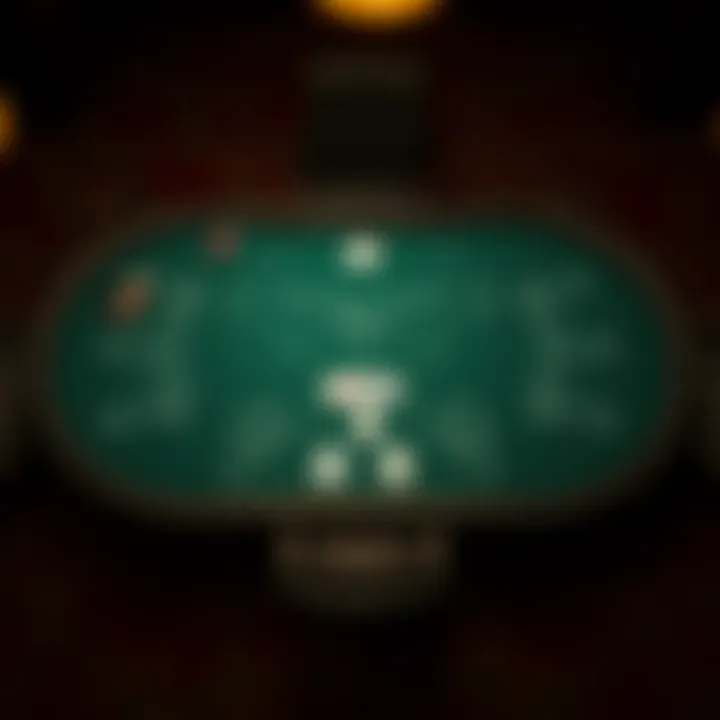
Incorporating Essential Accessories
Finally, add those critical accessories that elevate your blackjack table from basic to exceptional. While the essentials might vary from person to person, three crucial accessories often stand out: card shufflers, chip trays, and the dealer's area.
Card Shuffler
A card shuffler is a significant accessory in a blackjack table. Not only does it save time, but it also ensures fairness in the game as it shuffles the deck thoroughly. Manual shufflers are handy but automatics are preferred in many home setups. They streamline the process, allowing players to focus on enjoying the game rather than waiting for cards. The unique aspect of an automatic card shuffler is its capacity to handle multiple decks simultaneously, an invaluable feature during busy game nights. One disadvantage could be the initial cost; however, its reliability outweighs the expense.
Chip Trays
Every robust blackjack table needs chip trays to keep the gameplay organized. These trays provide designated space for different chip denominations, enhancing the flow of the game. Opt for trays that are sturdy and can accommodate a good number of chips without tipping over—nobody wants a cascade of chips during an intense moment. One key characteristic is that many chip trays fit seamlessly into the table’s design, often being built-in for visual aesthetics. An advantage of having chip trays is the ease of access they offer to players, thus making gameplay smoother.
Dealer's Area
Your dealer's area is the space where the dealer conducts the game. A well-defined area helps maintain order during games. Typically, this includes enough space for card management as well as placing chip trays and other necessary tools. It’s crucial to ensure that the dealer has adequate room to maneuver comfortably but remains close enough to players for interaction. The uniqueness of a good dealer's area lies in its user-centered design. It should facilitate the dealer’s movements while promoting engagement with players. This setup enhances the gaming experience but remember that overwhelming the dealer with too much clutter can detract from the flow of the game.
In this stage of construction, every little detail counts. It's not merely about building a table; it's about crafting an enjoyable, efficient gaming experience that captures the spirit of blackjack night!
Game Layout and Functionality
Creating a blackjack table isn't just about fashioning a surface to play on; it’s about crafting an environment that encourages strategic thinking, social interaction, and consistent engagement. Without a proper layout, you could find your gaming experience lacking, or worse, find it unsuitable for actual gameplay. The way your table is laid out significantly influences the pace of the game and how players interact with one another and the dealer. In this section, we'll delve into the various components that constitute an effective game layout and how they can enhance your playing experience.
Understanding Table Layout
A well-planned table layout can make or break the ambiance of any blackjack game. The main components include the shape of the table, layout of the betting areas, and positioning of necessary equipment. When it comes to shape, most tables are elliptical or round, which allows for better visibility for all players involved. The key is to let everyone interact comfortably while still keeping the dealer area in clear view.
Betting Zones: The betting areas should be easily distinguishable and adequately spaced to avoid confusion. Marking them clearly not only gives a professional touch but also minimizes any potential disputes among players about where bets are placed.
- Iconography: Using specific colors or symbols can help users navigate the layout easily.
- Visibility: Place areas that track the dealer’s total and player bets in spots that are readily visible but don’t block the flow of the game.
Optimal Player Arrangement
Player arrangements significantly contribute to the gameplay experience. To maximize interaction and comfort, players should have enough space between each other without feeling isolated. A crucial factor is the number of seats—typically, a blackjack table accommodates between 7 to 9 players, allowing enough space for chips and cards.
- Space for Movement: Each player should have enough elbow room while still being close enough to the dealer for efficient play. Think about using a layout that allows for easy access for chips and betting cards.
- Face-to-Face Engagement: Ensure that players can see and interact with each other and the dealer, encouraging conversation and camaraderie during play.
- Special Considerations for Spectators: If you've got folks lingering around, perhaps they deserve some space too. In joint games, those spectators shouldn’t feel cramped or be in danger of spilling anyone’s drink.
Dealer Space Requirements
The dealer’s area is crucial both for functionality and operational flow. This space should not only be ample enough for the dealer to stand comfortably but also strategically located to command attention and oversee player activities.
- Dealer's Responsibilities: A dealer often manages chips, calls out totals, and even engages with players. Thus, positioning should allow for easy access to both players and the table’s betting area.
- Chemical Spillover: Having a separate area for drinks or snacks might prevent precarious situations where spills can occur, maintaining the integrity of the gaming surface.
- Multi-functionality: The dealer’s space can be designed to accommodate various functions, like holding cards or keeping ongoing game statistics, thereby removing clutter from the playing area and keeping the table organized.
Creating an appealing game layout that prioritizes player comfort, engagement, and dealer functionality ultimately enhances the playing experience, inviting more lively interactions and a smoother flow of gameplay. As such, it’s essential not to overlook the details that, while perhaps small, collectively create an environment where enjoyment and strategy can thrive.
Finishing Touches
The journey of crafting your own blackjack table culminates in the finishing touches. These elements are more than mere aesthetics; they significantly influence both the functionality and longevity of your table. Just as a well-cooked meal needs seasoning, your blackjack table benefits from careful finishing. This section explores the crucial elements, benefits, and considerations associated with the finishing touches of your table.
Applying a Protective Finish
A protective finish is essential for safeguarding the wood from wear and tear. Think of it as a shield that keeps your tabletop looking sharp and new, even after countless rounds of cards. Various finishes exist, with polyurethane varnish being a popular choice due to its durability.
Considerations for selection:
- Sheen Levels: A matte finish offers a subtle look, while high-gloss finishes can provide a more polished appearance.
- Drying Times: Some finishes dry quickly but may require multiple coats, while others take longer but may be easier to apply in fewer layers.
Moreover, applying a finish isn't just about protection. It’s also about enhancing the wood's natural grain. This can bolster the visual appeal and elevate the table’s overall aesthetic.
Adding Felt or Cloth Surface
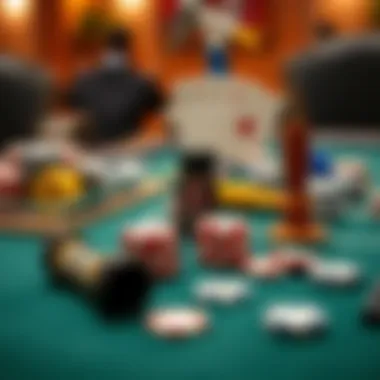
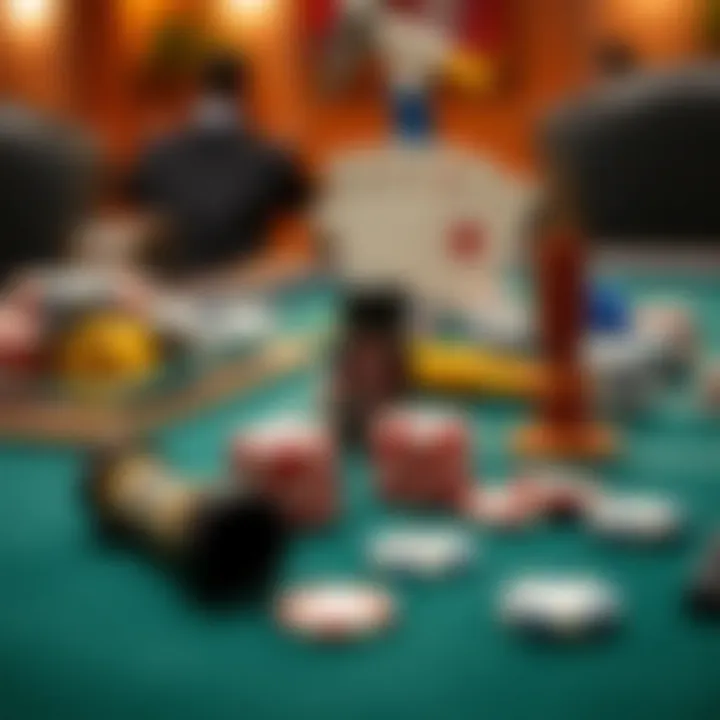
The underlining fabric of your blackjack table plays a vital role in both gameplay and comfort. The choice of felt, for instance, can influence the way cards slide across the table. Choosing a high-quality fabric like wool-blend felt can provide a smooth surface that feels good to the touch.
Here are important considerations:
- Color Selection: Daring colors can draw attention, while understated tones might appeal to a more traditional audience.
- Durability and Maintenance: Ensure the fabric can withstand spills, scratches, and extensive handling.
- Attachment Methods: Consider how you’ll secure the fabric. A staple gun can work wonders, but ensure you don’t over-stretch or damage the surface underneath.
Adding felt isn’t merely about looks. It creates a softer, quieter environment ideal for high-stakes games where concentration is key.
Quality Control Assessment
Lastly, before declaring your blackjack table a masterpiece, conduct a quality control assessment. This step is pivotal. Every detail, no matter how small, contributes to the overall user experience.
Here’s what to evaluate:
- Surface Flaws: Run your hand across the tabletop to check for any rough patches or inconsistencies.
- Structural Integrity: Ensure the frame is sturdy. A wobbly table can ruin the excitement of gameplay.
- Finish Quality: Inspect for runs or streaks in the finish that could detract from the table's beauty.
"A job well done is a job that can be seen and felt in the final result."
In essence, quality control is your final line of defense against dissatisfaction. By ensuring that every aspect of your blackjack table meets your standards, you set the stage for exciting game nights.
The End
The finishing touches are what differentiate a basic blackjack table from a personal masterpiece. They not only enhance the visual appeal but also ensure performance and longevity. By paying careful attention to the protective finish, fabric choices, and quality control processes, you can create a gaming table that will stand the test of time—and provide endless enjoyment to players at home.
Useful resources for related tips and advice can be found at Wikipedia and on forums such as Reddit.
Maintenance and Care
Keeping your blackjack table in prime condition is paramount for maintaining not only its aesthetic appeal but also its functionality during gameplay. Like any cherished item, a little attention goes a long way in preserving its quality and ensuring a delightful gaming experience. This section highlights the significance of routine maintenance and the care needed to extend the life of your handcrafted blackjack table.
Cleaning Procedures
Cleaning your blackjack table is not merely a chore; it's an act of preservation. Dust, dirt, and spills can quickly turn a stunning table into a less attractive setup. Here are a few steps to ensure its longevity:
- Regular Dusting: Use a soft, lint-free cloth to dust the surface. This avoids scratches and keeps the felt and finish looking sharp.
- Gentle Cleaning Solution: For deeper cleans, consider a gentle solution. A mix of warm water with a few drops of dish soap often does the trick. Wipe down the table with a damp cloth, then dry it immediately to avoid water damage.
- Stain Treatment: If a mishap occurs—a spilled drink, for instance—act swiftly. Blot the stain rather than rubbing it, which can spread the issue. Depending on the material of the surface, applying a suitable cleaner might be necessary to lift the stain.
Maintaining cleanliness also involves checking for debris in any accessories like card shufflers or chip trays. A quick inspection ensures everything works smoothly when friends gather for a game night.
Repair and Upkeep
Over time, even the most sturdy blackjack table may face a wear and tear. Regular checks and prompt repairs can save you from larger problems down the line. Some key considerations include:
- Inspecting for Damage: Look for cracks in the wood, fraying edges on the felt, or any loose parts. Addressing these issues early can prevent them from escalating into more significant repairs.
- Felt Replacement: If the playing surface begins to show significant wear, replacing the felt may be necessary. Consider durable yet stylish options that can add character to your table while enhancing gameplay.
- Reinforcing the Frame: The structure of your table should be rock solid. Tighten screws and bolts periodically, and consider reinforcing legs or joints that seem a little shaky.
Keeping a checklist for maintenance can be beneficial. It ensures you don't miss essential tasks that might keep your setup in good shape for years.
"A well-maintained table will see a lot more action and love from its players than one that falls into disrepair."
By taking heed of cleaning and repair protocols, you'll not only protect your investment but also enhance every gaming session, transforming it into an event that everyone will look forward to.
Final Thoughts
Constructing your own blackjack table is not just about assembling materials; it’s a voyage into customizing your gaming experience. This section encapsulates the key elements and benefits surrounding the process of creating a personalized blackjack table, underscoring not only the satisfaction derived from craftsmanship but also the potential for engaging social interaction within your space.
Evaluating Your Work
After all the sweat and patience invested in building your blackjack table, it's paramount to step back and assess your handiwork. Evaluation shouldn't merely be a glance over; it should involve a critical inspection of every detail. Look at the stability of the frame, ensuring it’s not teetering like a drunken sailor. Check the aesthetics, too—does the felt lay smooth and snug? Here are some evaluation criteria to consider:
- Structural Integrity: Gently shake the table to make sure it's sturdy.
- Surface Uniformity: Ensure there are no bumps or uneven sections on the playing surface.
- Design Cohesion: Is the color scheme harmonious and does it reflect the vibe you were aiming for?
- Functionality Check: Test out the accessories—does the card shuffler work smoothly, and do chip trays fit snugly?
Evaluating your work is more than just acceptance; it's the only way to ascertain the long-term utility of your table. A solid performance review may save you from future headaches and could even entrench your reputation as a masterful craftsman among friends.
Exploring Future Modifications
The journey doesn’t conclude with the completion of your blackjack table. Instead, think of it as a foundation for future enhancements. Once your table has seen a couple of games, new ideas are sure to sprout. Consider modifications that might add functionality or elevate the overall look. Here are a few avenues to explore:
- Lighting Enhancements: Install ambient lighting or LED strips around the edges for a glitzy Las Vegas feel.
- Add-On Accessories: Integrate built-in card holders or cup holders for a more user-friendly gaming environment.
- Thematic Updates: Change up the felt design to reflect seasonal themes or special occasions.
- Tech Integration: Think about incorporating electronic scorekeeping or betting interfaces for a modern twist.
These modifications do not only bolster the player's experience but also display your evolving craftsmanship. Each addition can create a narrative that adds character to your game nights.
Crafting a blackjack table is a testament to your creativity and commitment to providing a superb gaming experience. Embrace the journey, evaluate your work, and let imagination fuel the upgrades ahead.
In summary, taking the time to reflect on the completed project and envision future possibilities will ultimately amplify the depth of your blackjack gaming experience.







